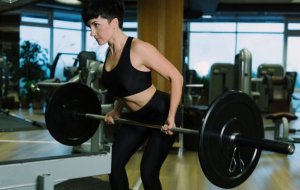Barbell Row

This very popular gym exercise has its own technique, which must be followed to avoid injuries or less than stellar results. There are different variations of barbell rows. However, we recommend that you start with the basic or more traditional exercise. We will tell you how to do this below!
What is the barbell row and what muscles does it involve?
Before starting, you should know that the barbell row is a difficult exercise. That doesn’t mean you can’t do it, but you have to keep in mind that it’s not for beginners in the gym, or to be performed without prior advice from a doctor. Fitness experts indicate that it’s more complicated than the bench press, but easier than squats or deadlifts.
Don’t feel frustrated or disappointed. You should know that if you can lift a certain weight with this exercise, it means that your strength has increased, thanks to the routine. Therefore, it’s a good way to measure your achievements and changes.

The barbell row is a very good exercise to work and strengthen the back and provides the ability to perform a more complicated routine. In turn, if you practice correctly, the arms will increase their strength and become more defined.
In addition, you work your abs, because during the movement, your belly must be contracted. Ideal for those who want a defined abdomen but hate the exercises that are needed to achieve it!
The femoral and gluteal muscles are also reinforced. This is due to the contraction and strength that they must have when ‘anchoring’ to the ground.
How to do a barbell row
Pay close attention to the steps that you must follow to correctly execute the exercise. You have to do the barbell row standing up, with your legs separated to hip width, and with your toes and knees turned slightly to the sides.
Place the bar, loaded with the appropriate weights near the tibia. To grab it, you must choose the prone grip, that is so the thumbs will wrap the bar. Why? Because in this way you will tighten the bar more, and more muscles will be involved.
The width of the grip must be more closed than in a bench press, and wider than in a deadlift. A wider stance shortens the range of movement and causes the arms to tilt.
Bring your torso forward at the same time that you slightly bend your knees. The glutes should be ‘backward’ throughout the execution. Take the bar with your arms stretched in front of the body.
Without changing the position of your back (parallel to the ground), bend your elbows and bring them back so that they go beyond the spine. But, pay attention! Don’t be too ‘open’ and separated from your torso, or you will be using too much force, particularly in the wrists.

Once you hold the movement for a few seconds, slowly lower the barbell until your arms are fully stretched and the bar is hanging close to your feet.
Tips for the rowing with bar
One of the most common questions regarding the execution of this exercise is regarding breathing. Because, the position of the torso doesn’t allow for very deep breathing. We recommend that you take a breath before the start position.
Another question that we may consider is regarding how far the bar should go. This is simply to the same place where it’s supported for bench press. Lifting towards the chest requires greater stability in the lower back and doing it to waist height, will displace the effort towards the high and middle back. Everything depends on what you want to work!
This very popular gym exercise has its own technique, which must be followed to avoid injuries or less than stellar results. There are different variations of barbell rows. However, we recommend that you start with the basic or more traditional exercise. We will tell you how to do this below!
What is the barbell row and what muscles does it involve?
Before starting, you should know that the barbell row is a difficult exercise. That doesn’t mean you can’t do it, but you have to keep in mind that it’s not for beginners in the gym, or to be performed without prior advice from a doctor. Fitness experts indicate that it’s more complicated than the bench press, but easier than squats or deadlifts.
Don’t feel frustrated or disappointed. You should know that if you can lift a certain weight with this exercise, it means that your strength has increased, thanks to the routine. Therefore, it’s a good way to measure your achievements and changes.

The barbell row is a very good exercise to work and strengthen the back and provides the ability to perform a more complicated routine. In turn, if you practice correctly, the arms will increase their strength and become more defined.
In addition, you work your abs, because during the movement, your belly must be contracted. Ideal for those who want a defined abdomen but hate the exercises that are needed to achieve it!
The femoral and gluteal muscles are also reinforced. This is due to the contraction and strength that they must have when ‘anchoring’ to the ground.
How to do a barbell row
Pay close attention to the steps that you must follow to correctly execute the exercise. You have to do the barbell row standing up, with your legs separated to hip width, and with your toes and knees turned slightly to the sides.
Place the bar, loaded with the appropriate weights near the tibia. To grab it, you must choose the prone grip, that is so the thumbs will wrap the bar. Why? Because in this way you will tighten the bar more, and more muscles will be involved.
The width of the grip must be more closed than in a bench press, and wider than in a deadlift. A wider stance shortens the range of movement and causes the arms to tilt.
Bring your torso forward at the same time that you slightly bend your knees. The glutes should be ‘backward’ throughout the execution. Take the bar with your arms stretched in front of the body.
Without changing the position of your back (parallel to the ground), bend your elbows and bring them back so that they go beyond the spine. But, pay attention! Don’t be too ‘open’ and separated from your torso, or you will be using too much force, particularly in the wrists.

Once you hold the movement for a few seconds, slowly lower the barbell until your arms are fully stretched and the bar is hanging close to your feet.
Tips for the rowing with bar
One of the most common questions regarding the execution of this exercise is regarding breathing. Because, the position of the torso doesn’t allow for very deep breathing. We recommend that you take a breath before the start position.
Another question that we may consider is regarding how far the bar should go. This is simply to the same place where it’s supported for bench press. Lifting towards the chest requires greater stability in the lower back and doing it to waist height, will displace the effort towards the high and middle back. Everything depends on what you want to work!
This text is provided for informational purposes only and does not replace consultation with a professional. If in doubt, consult your specialist.








